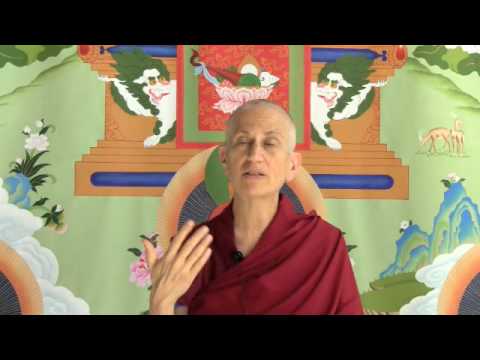Visualizing sentient beings
Stages of the Path #56: Refuge Ngöndro Part 5
Part of a series of short talks on the preliminary practice (ngöndro) of taking refuge.
- A continuing explanation of the refuge field, the sentient beings surrounding us
- You can’t ignore the people you don’t get along with, as they’re between you and the Buddha in the visualization
- Why compassion is included as a cause for Mahayana refuge
Stages of the Path 56: Visualization sentient beings (download)
We’ve been talking about the visualization and we completed visualizing the gurus, the Buddhas, the Dharma, and the Sangha. Now, around us, it says:
Surrounding me are gathered all beings of the six realms, overwhelmed by the various difficulties and sufferings of samsara. In the face of such constantly recurring problems, we seek the protection and guidance of the spiritual mentors and the Three Jewels.
We visualize it as I’m sitting here facing the Three Jewels. There, on my left side, my mother; on my right side, my father. All other sentient beings around me—in human form—and all the people I don’t like, who I’m afraid of, who I’m mad at, who I want to get away from, are all sitting right in front of me. And we’re all facing the Buddha, Dharma, Sangha together.
What this is indicating is that there is no way that you can ignore the people that you don’t get along with, because they’re sitting there right between you and the refuge field! You’ve got to look at them. You can’t ignore them, you can’t leave them out. We’re all facing the Buddha, Dharma, Sangha together because we’re all in the same state—we’re all afflicted by the three kinds of dukkha: the dukkha of pain, the dukkha of change, and then pervasive-conditioning dukkha. We’re all subjected to those. You can include a whole meditation here on the nature of samsara if you want to.
We’re there with everybody else. Everyone’s equally afflicted by the first two noble truths and we’re all seeking refuge in the Three Jewels together. It’s not like we’re superior and magnanimous and leading the rest of the slobs along with us. There is no reason for condescension here. We have the privilege to sit in the presence of the Three Jewels and to lead everybody else in taking refuge.
It’s quite a beautiful meditation when you do this. I say this because you see that when you take refuge it’s not like you’re running away from all the sentient beings that you don’t like and all the hassles they cause you—because they’re right there, in your refuge visualization. You’ve got to include them in taking refuge. This is why, when we speak of Mahayana refuge, we talk about the causes not only being an awareness of the danger of saṃsara and faith and confidence in the ability of the Three Jewels to guide us from it, but also compassion for everybody else who is in the same boat.
This can be a very profound meditation when you do it over a period of time. It really can help us make peace with a lot of situations in our past and a lot of people in our lives for whom our mind has constructed very rigid, inherently existent identities. We have to start chipping away at these, seeing that everybody is in the same boat. And that as we take refuge—which we’ll get into tomorrow—that the light from the Buddha, Dharma, Sangha shines equally upon all of us and fills all of us, purifying us, inspiring us.
Venerable Thubten Chodron
Venerable Chodron emphasizes the practical application of Buddha’s teachings in our daily lives and is especially skilled at explaining them in ways easily understood and practiced by Westerners. She is well known for her warm, humorous, and lucid teachings. She was ordained as a Buddhist nun in 1977 by Kyabje Ling Rinpoche in Dharamsala, India, and in 1986 she received bhikshuni (full) ordination in Taiwan. Read her full bio.


